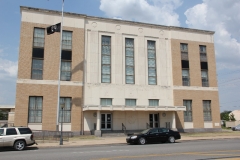| Address: | 120 East Illinois Ave, Vinita Oklahoma 74301 | County | Craig |
| Started: | 1938 | Completed | 1939 |
| Agencies: | Treasury Department | NRHP: | No |
Current Usage
Post Office
Description:
The post office contains two sets of three murals each by Randall Davey. The murals were painted in 1941 with funding from the Treasury Section of Fine Arts.
In these murals, Randall Davey portrayed the history of the Cherokee Nation in a highly sympathetic manner. This tribe, one of the “5 Civilized Tribes” had a troubled history including the forced move to Oklahoma on the “Trail of Tears”. Notes on display near the murals explain the historical basis of the works. (Some pictured below).
Randall Davey was a major figure in American painting in the 20th century. He was born in New Jersey and initially studied architecture, but left for New York City in 1907 to study with Robert Henri, then on to the Art Students League. Notably, he was one of the exhibitors at the seminal Armory Show in 1913. He painted with Henri, George Bellows, John Sloan, and many other artists. He moved to Santa Fe in 1919. He is exhibited at many major museums through-out the United States. He died in a car accident driving to California in 1964.[1]
This is a three-story brick building in the Commercial Style with some modest Art Deco detailing. The central portion of the tripartite facade is slightly recessed and consists of limestone. Four fluted pilasters decorate the limestone on the second story, while low-relief engravings of ears of corn mark the wall space above the doors. An engraved eagle forms the centerpiece of the building between the two double-door entrances. Continuous courses of limestone encircle the building between the first and second stories, and at the top. Tall, slender windows enhance the verticality of the building.
Although the architecture of the building is modest, the building has retained its integrity. Moreover, inside the building on the first floor is the six-panel mural cycle, Cherokee History, painted by Randall Davey. These panels were created through the Section, one of the New Deal art programs. This building is noteworthy because of its association with public art depicting historical events of significance at the local, regional, and national levels.




Leave a Reply